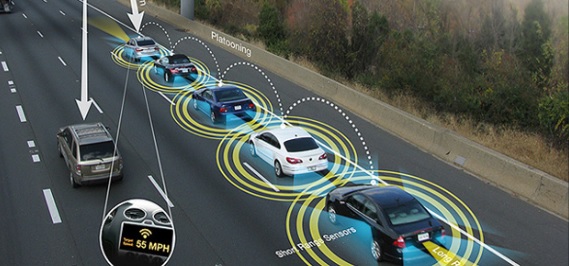HNTB
As emerging technologies such as connected and autonomous vehicles are deployed on a wider scale, disruptive innovations are poised to revolutionize surface transportation infrastructure and personal mobility.
7 in 10 Americans said they believe autonomous vehicles will routinely navigate the nation’s streets and highways within 15 years
Americans can see the future taking shape and anticipate dramatic changes. In a recent HNTB America THINKS survey, The Road to Autonomous Vehicles – 2018, seven in 10 Americans said they believe autonomous vehicles will routinely navigate the nation’s streets and highways within 15 years. This is in line with what many experts predict.
If this kind of rapid adoption indeed takes place, tomorrow’s transportation systems will look and operate much differently than they do today. Autonomous vehicles — from cars, to shuttles and buses, to freight trucks — will communicate with each other and with related highway infrastructure, which can improve safety while delivering benefits to all road users. For example, for every driver unexpected starts and stops on highways would virtually disappear, and safety for a variety of travelers would improve.

With these aims in mind, industry and government are moving toward the creation of a safe connected vehicle environment. Many states are tracking with this technological evolution, even if they are proceeding at different speeds. According to a report by the Governors Highway Safety Association, 37 states and the District of Columbia had enacted autonomous vehicle-focused legislation or issued related executive orders as of June 2018. A dozen states had cleared the way for testing or deployment (with some conditions) without a human in the vehicle.
Federal legislation to enable self-driving vehicles — which would help to stitch together this patchwork of state and local policies — is moving forward in Washington, D.C., as well.
Innovation from Every Direction
The private sector has been gearing up for the change for many years, with automakers and technology companies racing to bring effective solutions to market.
Major companies routinely get headlines for their on-the-road test cars, but many hundreds of small companies and researchers are working to solve myriad technical problems. For example, in mid-2018 a research team from Stanford University brought forth a new “hybrid” optical-electrical camera that promises to crunch more visual and sensor data, more quickly and in a smaller, lighter package.
A consumer-grade, fully automated vehicle likely will be available for purchase within the next 5 years
Given the amount of attention and resources being poured into research and development, a consumer-grade, fully automated vehicle likely will be available for purchase within the next five years. However, due to cost, policy and regulatory issues, formal consumer adoption on roadways might take another five to 10 years after the initial vehicles hit the market.
Within the next couple of years, some companies are poised to initiate ride-hailing and package delivery services in which the costs of automated vehicles can be spread across multiple users and more hours of the day. This type of fleet-ownership model also will simplify some of the policy and regulatory issues associated with personal vehicle ownership.
Some deployments are already occurring in smart city programs around the nation, and autonomous shuttles can be seen at airports and in cities around the world. These eight- to 16-passenger shuttles can be used to connect passengers to the first and last mile of transit systems, extending the reach of existing bus and rail service into neighborhoods. These deployments also may soon include smaller vehicles, operating on-demand, and driving on mixed-use road facilities where some of the policy, regulatory and insurance factors can be more readily addressed than on public roadways.
Read Autonomous Vehicles: Where Are They Taking Us Next? - Part 2




